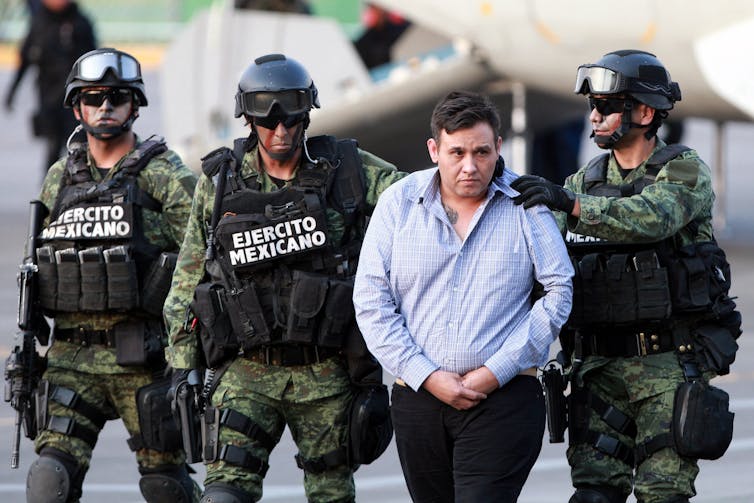Mexico’s “war on drugs” began in 2006, when the newly elected president, Felipe Calderón, ordered thousands of troops onto the streets in an attempt to combat drug violence.
The results have been disastrous. The government’s military operations have forced drug cartels to recruit intensively to protect their trafficking routes, and homicide rates have soared. In 2021, 28 in every 100,000 people were killed in Mexico – around three times more than in 2005.
For a long time, researchers, international organisations and politicians have assumed that the group most vulnerable to cartel recruitment in Mexico was young men who are “not in education, employment or training”.
Based on that assumption, the current Mexican government introduced an employment programme in 2019 called Jóvenes construyendo el futuro (Youth building the future). The programme offers on-the-job training opportunities for young people aged 18 to 29 years who neither work nor study in an attempt to tackle youth participation in criminal violence.
The programme was ostensibly designed to attract young men who are out of work into employment. However, in reality, it has hardly improved the employment prospects for the most deprived youth and has instead resulted in the recruitment primarily of women with high-school degrees. Paradoxically, the programme offers paid internships in small businesses for high-school graduates, or in larger companies and the government for those with a university degree.
In my own research, which was published in March 2024, I challenge the assumption that Mexico’s unemployed or out-of-school youth are prone to crime. My findings reveal that most of the young men that are recruited by criminal organisations were not idle before their involvement in drug cartels. They were, in fact, working in precarious conditions.

The Mexican government’s National Institute of Statistics and Geography conducted a national survey of the country’s imprisoned population in both 2016 and 2021. Using the 2021 survey, I studied the socioeconomic data collected from inmates who were convicted of homicide after the onset of the war on drugs.
More than 29,000 inmates were surveyed in total. The overwhelming majority were men (94.85%), over half (52.2%) of whom were younger than 29 years old when they were detained. Most of them had previously experienced hunger (90.7%), had some form of employment (93.6%), and used to work as farmers or manual workers (70.7%). Slightly more than half (54.8%) had left education early to work.
This profile is expected given the underlying socioeconomic conditions in Mexico. Unemployment in the country is well below the global average and precarious work is widespread.
The majority of farm, manual and self-employed workers do not have access to social security, and their low salaries leave them vulnerable to poverty. So, the cartels offer an attractive alternative for many young Mexican men who face little chance of attaining social mobility and earning a decent salary.
Workplace insecurity
The struggles facing Mexico’s youth can be traced back to the 1990s. In the wake of a series of severe economic crises, Mexico dismantled its minimum wage policies and worker protections as the country geared up for growth based on exports.
In 1994, the North American Free Trade Agreement (Nafta) established a free-trade zone in North America, lifting tariffs on the majority of goods traded between the US, Canada and Mexico. However, trade liberalisation seems to have magnified social exclusion in Mexico’s key trafficking regions and, in turn, has pushed young people towards the cartels.
Research from 2019 found that reforming the agricultural sector in regions where drugs are produced while simultaneously failing to absorb surplus labour in manufacturing jobs inadvertently increased the flow of workers into the drugs trade. According to the same study, homicide rates are higher in Mexican municipalities that were more exposed to trade following the implementation of Nafta.
That said, most of the young Mexican men that are working in precarious conditions do not participate in criminal violence. The government tends to overemphasise some socioeconomic profiles in an attempt to find a “silver bullet” policy that will prevent the involvement of vulnerable youth in crime.
There are plenty of other factors that could help explain youth involvement in Mexican cartel violence. And my research shows that young homicide inmates come from very diverse conditions. Some experienced parental abuse as children (19%) and lived in female-led households (13.3%), testifying to the role of parental influence on young criminals.
Studies have also found that former members of the military have played a key part in Mexico’s organised crime landscape. The founders of Los Zetas, once one of Mexico’s most notorious drug cartels, were defectors from the Mexican Army’s Airborne Special Forces Group. My findings suggest that 13.3% of homicide inmates had worked in the police or the military.

Furthermore, 57.7% of young men incarcerated in Mexican prisons had a darker skin tone than the Mexican average. This is an indication of the marginalisation by skin colour of parts of the Mexican population. And 82.5% of homicide inmates were regular alcohol consumers. Research suggests that Latin American nations with high alcohol consumption levels are associated with higher homicide rates.
Tackling the cause of cartel violence may seem noble. But it places the blame on young people and their conditions rather than addressing the structural inequalities in Mexican society. Reducing violence in Mexico will require a reconsideration of militarisation and a socioeconomic model that promotes job insecurity.

